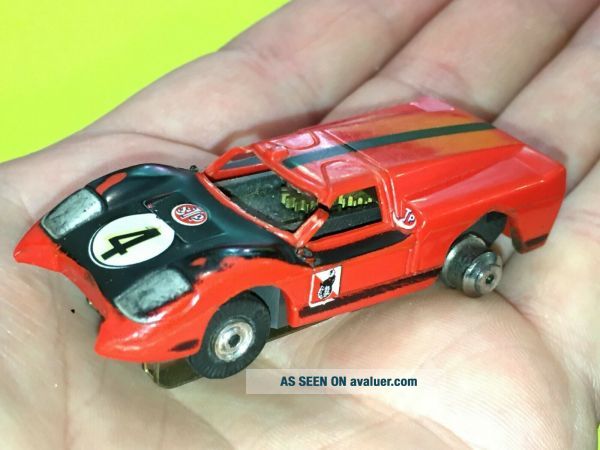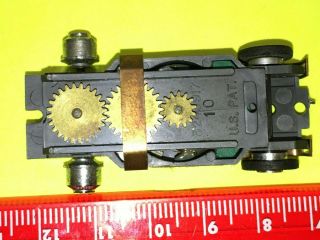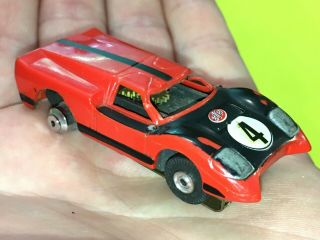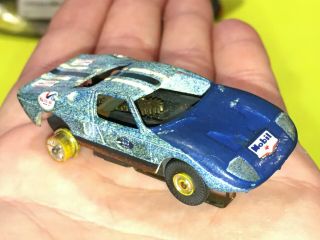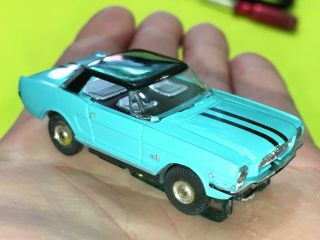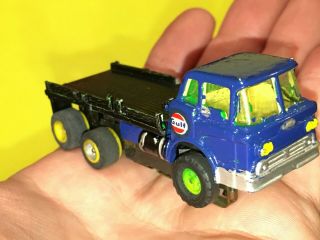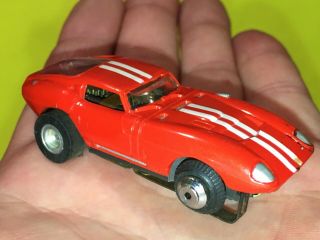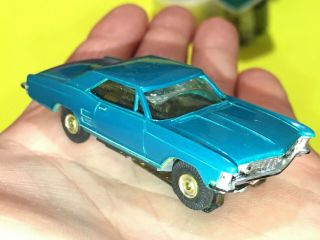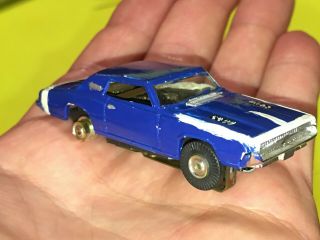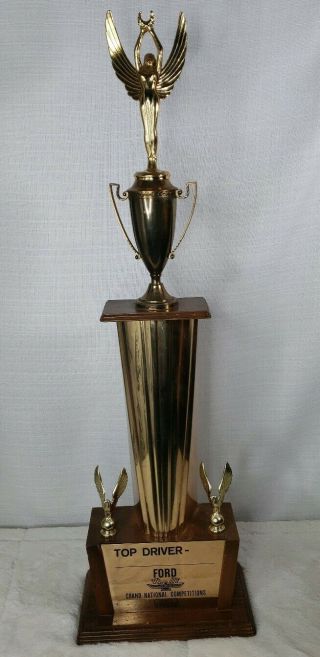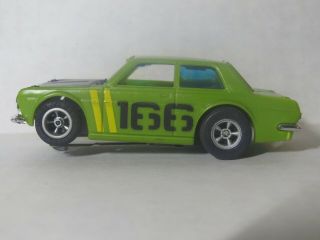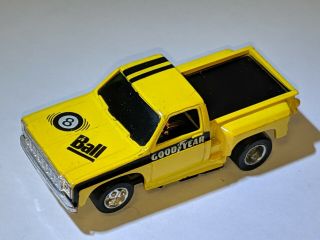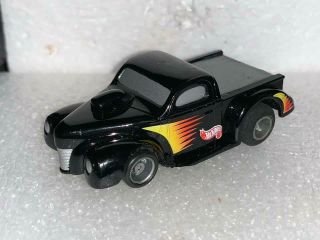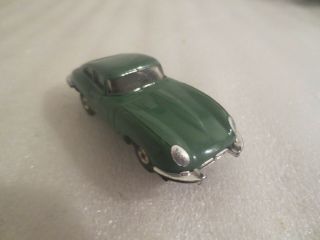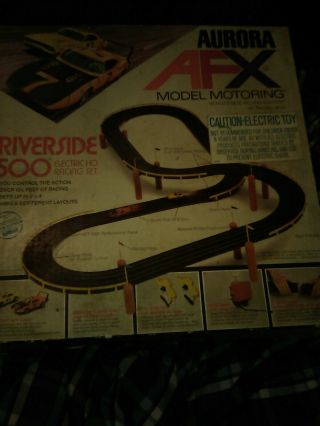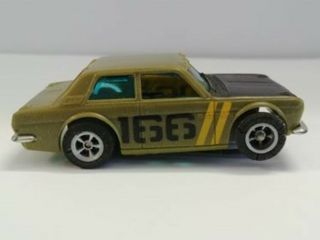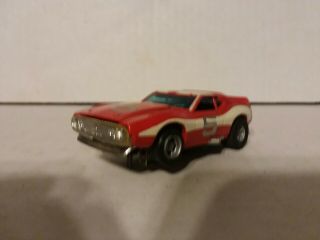VINTAGE AURORA / AFX THUNDERJET / T - JET HO SCALE RED & BLACK FORD J SLOT CAR
Item History & Price
| Reference Number: Avaluer:27529282 | Type: Car |
| Brand: AFX | UPC: Does not apply |
SLOT BODY IS USED WITH SOME WEAR AND DAMAGE (AS SHOWN) TIRES INCLUDED ARE OLD & CRACKING AND PROBABLY NEED REPLACING (AS SHOWN)SLOT MOTOR TESTED WITH 9-VOLT & DID NOT TURN
*DETAILED PICTURES PROVIDED - WHAT YOU SEE IS WHAT U GET*
*INTERNATIONAL SHIPPING DONE THROUGH EBAY GLOBAL SHIP* *HAPPY BIDDING!!!*A slot car or slotcar is a powered min...iature auto or other vehicle that is guided by a groove or slot in the track on which it runs.[1][2] A pin or blade extends from the bottom of the car into the slot. Though some slot cars are used to model highway traffic on scenic layouts, [3] the great majority are used in the competitive hobby of slot car racing or slot racing. Description[edit]A typical, 1:32 scale, Audi R8R slot car by CarreraSlot cars are usually models of actual automobiles, though some have bodies purpose-designed for miniature racing. Most enthusiasts use commercially available slot cars (often modified for better performance), others motorize static models, and some "scratch-build", creating their own mechanisms and bodies from basic parts and materials.Drivers generally use a hand-held controller to regulate a low-voltage electric motor hidden within the car. Traditionally, each car runs on a separate lane with its own guide-slot (though recently developed digital technology can allow cars to share and change lanes). The challenge in racing slot cars comes in taking curves and other obstacles as fast as possible without causing the car to lose its grip and spin sideways, or to 'deslot', leaving the track altogether.Some enthusiasts, much as in model railroading, build elaborate tracks, sculpted to have the appearance of a real-life racecourse, including miniature buildings, trees and people. Hobbyists whose main goal is competition often prefer a track unobstructed by scenery.Model motorcycles, trucks and other vehicles that use the guide-slot system are also generally included under the loose classification of "slot car."How it works[edit]Typical electrical circuit of a 1:24 or 1:32 slot car track.The diagram at right shows the wiring of a typical 1:24 or 1:32 slot car setup. Power for the car's motor is carried by metal strips next to the slot, and is picked up by contacts alongside the guide flag (a swiveling blade) under the front of the slot car. The voltage is varied by a resistor in the hand controller. This is a basic circuit, and optional features such as braking elements or electronic control devices are not shown. Likewise, the car's frame or chassis has been omitted for clarity.HO slot cars work on a similar principle, but the current is carried by thin metal rails that project barely above the track surface and are set farther out from the slot. The car's electrical contacts, called "pickup shoes", are generally fixed directly to the chassis, and a round guide pin is often used instead of a swiveling flag.Today, in all scales, traction magnets are sometimes used to provide downforce to help hold the car to the track at higher speeds, though some enthusiasts believe magnet-free racing provides greater challenge and enjoyment and allows the back of the car to slide or "drift" outward for visual realism.Common slot car scales[edit]Models of the Ford GT, in 1:24, 1:32 and nominal HO scales. The 1960s-era HO model has been widened to accept the mechanism.There are three common slotcar scales (sizes): 1:24 scale, 1:32 scale, and so-called HO size (1:87 to 1:64 scale). These are also commonly written as 1/24, 1/32, 1/87 and 1/64. Usual pronunciation is "one twenty-fourth", "one thirty-second", and so on, but sometimes "one to twenty-four", "one to thirty-two".1:24 scale cars are built so that one unit of length (such as an inch or millimetre) on the model equals 24 units on the actual car. Thus, a model of a Jaguar XK-E (185 inches or 4.7 m overall length) would be 7.7 inches (20 cm) long in 1:24 scale. 1:24 cars require a course so large as to be impractical for many home enthusiasts, so most serious 1:24 racing is done at commercial or club tracks.1:32 scale cars are smaller and more suited to home-sized race courses, but they are also widely raced on commercial tracks, in hobby shops or in clubs. This scale is the most popular in Europe, and is equivalent to the old #1 gauge (or "standard size") of toy trains. A Jaguar XK-E would be about 5.8 inches (15 cm) in 1:32 scale.HO-sized cars vary in scale. Because they were marketed as model railroad accessories, the original small slot cars of the early 1960s very roughly approximated either American and European HO scale (1:87) or British OO scale (1:76). As racing in this size evolved, the cars were enlarged to take more powerful motors, and today they are often 1:64 or larger in scale; but they still run on track of approximately the same width, and are generically referred to as HO slot cars. They are usually not accurate scale models, since the proportions of the tiny bodies must often be stretched to accommodate a standard motor and mechanism. The E-Jaguar scales out to 2.1 inches (5.3 cm) long in 1:87 and 2.9 inches (7.4 cm) in 1:64). Although there is HO racing on commercial and shop-tracks, probably most HO racing occurs on home racetracks.In addition to the major scales, slot cars have been commercially produced in 1:48 scale and 1:43 scale, corresponding to O gauge model trains. 1:48 cars were promoted briefly in the 1960s, and 1:43 slot car sets are generally marketed today (2007) as children's toys. So far, there is little organized competition in 1:43, but the scale is gaining some acceptance among adult hobbyists for its affordability and moderate space requirements. The E-Jaguar would be 4.3 inches (11 cm) long in 1:43.History[edit]The earliest known commercial slotcars (Lionel Corp., 1912). They appeared on the cover of the 1913 and 1914 Lionel catalogues.[4]The first commercial slot cars were made by Lionel (USA) and appeared in their catalogues from 1912, [5] drawing power from a toy train rail sunk in a trough or wide slot between the rails.[4] They were surprisingly similar to modern slot cars, but independent speed control was available only as an optional extra. Production was discontinued after 1915. Sporadically over the next forty years, several other electrically powered commercial products came and went.[6] Although a patent was registered as far back as March 1936 for a slot car, [7] until the late 1950s, nearly all powered toy vehicles were guided by raised rails, either at the wheels (railroad-style), or at the lane center, or edge.By the late 1930s, serious craftsmen/hobbyists were racing relatively large (1:16 to 1:18 scale) model cars, powered by small internal combustion engines, [8] originally with spark-ignition, later with glow plug engines. For guidance, the cars were clamped to a single center rail, or tethered from the center of a circular track, then they were started and let go for timed runs. There was no driver control of either the speed or steering, so "gas car" racing was largely a mechanic's hobby.[1][9] In the 1940s hobbyists in Britain began to experiment with controllable electric cars using handbuilt motors, [10] and in the 1950s using the small model train motors that had become available.[11] In 1954, the Southport Model Engineering Society in the U.K. was challenged by a patent-holder for using rail-guided gas-car exhibitions to raise funds, [12] so, as a replacement, the members constructed an electric racecourse, a groundbreaking six-lane layout nearly 60 feet long, for 1:32 rail-guided cars, which is widely considered to be the progenitor of electric rail- and slot-racing. In 1955–1956, several clubs in the U.K. and U.S., inspired by the Southport layout, [13] were also racing electric cars guided by center rails, and soon after, by slots in the track surface.[14] The term "slot car" was coined to differentiate these from the earlier "rail cars".[15] As the member-built club layouts proliferated, the relative advantages of rail and slot were debated for several years, but the obtrusive appearance of the rails and their blocking of the car's rear wheels when sliding through corners were powerful disadvantages.[16] New clubs increasingly chose the slot system. By 1963, even the pioneer rail-racing clubs had begun to switch to slots.[17]Very early Scalextric slot car models in 1:30 scale, circa 1957. These metal-bodied racers were electrified versions of Scalex clockwork cars, and are among the first commercially offered slot cars of the modern era. They represent the Maserati 250F (left) and the Ferrari 375 Grand Prix cars.In 1957, Minimodels (UK) converted its Scalex 1:30 (later, 1:32) clockwork racers to electricity, creating the famous Scalextric line of slot-guided models, [18] and Victory Industries (UK) introduced the VIP line, [19][20] both companies eventually using the new plastic-molding technologies to provide controllable slot racers with authentic bodies in 1:32 scale for the mass market. Both lines included versatile sectional track for the home racer - or the home motorist; VIP produced sports cars and accessories slanted toward a "model roadways" theme, [21] while Scalextric more successfully focused on Grand Prix racing.[22]As Scalextric became an instant hit, American hobbyists and manufacturers were adapting 1:24 car models to slots, [23] and British-American engineer Derek Brand developed a tiny vibrator motor small enough to power model cars roughly in scale with HO and OO electric trains. In 1959, Playcraft division of Mettoy produced these in the UK, and a year later, Aurora Plastics Corp. released HO vibrator sets with huge success in the USA. The tiny cars fascinated the public, and their cost and space requirements were better suited to the average consumer than the larger scales. In only a year or two, Scalextric's 1:32 cars and Aurora's "Model Motoring" HO line had set off the "slot car craze" of the 1960s.[24]An Aurora "Thunderjet-500" HO chassis and motor, 1963-1971.The slot car craze was largely an US phenomenon, [25] but, commercially, it was a huge one. In 1963, after a million and a half[24] had been produced, Aurora replaced the trouble-prone vibrator cars with an innovative flat-commutator ("pancake") motor, [26] also created by Brand, and what is probably the best-selling slot car in history, the Aurora Thunderjet-500 was born. Faller (Germany) produced it for sale in Europe, and competing companies tried in vain to match the speed and reliability of Brand's design. The Thunderjets and their improved versions, the AFX, sold in the tens of millions, [27] completely dominating the HO market for almost a decade, until challenged by the Tyco cars in the early 1970s.[24]By the late 1970s the slot car boom was well over, the model train tie-ins and miniature motoring concepts largely forgotten, and the market returned to the more serious racing hobbyist, with local and national racing organizations evolving to set standards and rules for different classes of competition. Technological innovation brought much higher speeds in all scales, with faster motors, better tires, and traction magnets to hold the cars down in curves, though some of the 1960s enthusiasts thought that slot racing had become too specialized for the casual hobbyist, and fondly remembered the more primitive cars of their youth as not so fast, but more fun.[citation needed]In the 1990s, computer design and methods of printing on 3-D objects helped create much more detailed and authentic models than the simple shapes and rudimentary graphics of the slot car boom. In addition, newly manufactured replicas of Aurora's HO slot cars of the 1960s and 1970s appeared on the market and consumers gained the option of racing either the modern high-tech wondercars or the more basic designs of an earlier time. In 2004, the Digital Command Control (DCC) systems, which had revolutionized model railroading in the 1990s, began to appear in 1:32 slot cars, offering the ability to race multiple cars per lane with more realistic passing.In 2012, Hong Kong Chinese inventor Mak Wing Kwong introduced the "Dynamic Motion Express" slot car system. The DMX track has a series of parallel slots, allowing drivers to choose lanes on the inside, middle or outside of the raceway, passing or blocking other racers. DMXslot cars have a rotating mechanism underneath each car with four pins that retract and protrude as the driver commands the car to move left or right. The car disengages its pin with one lane’s slot, moves to one side or the other, and reinserts a pin in the new lane’s slot.[28]Related systems and developments[edit]Digital track (SCX, 1995). Digital technology allows cars to change lanes at crossing points and passing-lane sections.A number of technological developments have been tried over the years to overcome the traditional slot car's limitations. Most lasted only a few years, and are now merely historical curiosities.Around 1962, AMT's Turnpike system (USA) used multiple electrical pickups within the slot to allow drivers to control, to a limited extent, the steering of special 1:25 cars.In the late 1960s the Arnold Minimobil system (Germany), also marketed as the Matchbox Motorway (UK), used a long hidden coil, powered by track-side motors, to move die-cast or plastic cars down the track via a slot and detachable pin. Cars in different lanes could race, but cars in the same lane moved at the same speed, separated by a fixed distance.Also in the '60s Eldon Industries, Inc. produced 1/32 scale slot cars and sets with a very modern lane change system for analogue cars branded Selectronc that used lane change sections with a dedicated lane change controller. The cars and transformer used diodes to separate the control signals from the hand controllers that allowed for both cars to run independently in the same lane.In the mid and late 1970s several manufacturers including Aurora, Lionel and Ideal (USA) introduced slotless racing systems that theoretically allowed cars to pass one another from the same lane. Most used a system of multiple power rails that allowed one car to speed up momentarily and move to the outside to pass. Though briefly successful as toy products, none of these systems worked well enough to be taken up by serious hobbyists.[24]In 2004, a number of traditional slot car manufacturers introduced digital control systems, which enable multiple cars to run in the same lane and to change lanes at certain points on the course. Digitally coded signals sent along the power strips allow each car to respond only to its own controller.[29]In addition, imaginative manufacturers have used the slot track system to allow the racing of a variety of unusual things, including motorcycles, [1] boats, [30] airplanes, [31] spacecraft, [31] horses, [1] fictional and cartoon vehicles, [24] snowmobiles, [24] and futuristic railroad trains.[32]Slot car tracks[edit]Three-lane routed track inspired by the Targa FlorioPlastic track created for charity eventThe first sectional slot tracks from Scalextric and VIP were molded rubber and folded metal, respectively, but modern slot tracks fall into two main categories: plastic tracks and routed tracks.Plastic tracks are made from the molded plastic commercial track sections. Sectional track is inexpensive and easy to assemble, and the design of the course can be easily changed. The joints between the sections, however, make a rough running surface, prompting the derisive term "clickety-clack track". The many electrical connections cause voltage drop and contribute to more frequent electrical problems. For a permanent setup, the joints can be filled and smoothed, and the power rails soldered together or even replaced with continuous strips, but the surface is seldom as smooth as a good routed track.Routed tracks have the entire racecourse made from one or a few pieces of sheet material (traditionally chipboard or MDF, but sometimes polymer materials) with the guide-slots and the grooves for the power strips cut directly into the base material using a router or CNC machining. This provides a smooth and consistent surface, which is generally preferred for serious competition.Electrical equipment[edit]Types of Slot Car Controllers (L to R, from top)Telegraph KeyThumb buttonWheel or Dial RheostatCarbon Disc PlungerRheostat PlungerFull-Grip StylePistolgrip RheostaElectronic ControllerPower for most slot car tracks comes from a power pack. Power packs contain a transformer, which reduces high voltage house current to a safe 12 to 20V, depending on car type) and usually a rectifier, which changes AC to DC, for cooler running and simpler motors. High-capacity lead-acid batteries are sometimes used for hobby slot cars. Toy race sets may use dry cell batteries at 3 to 6 volts.Controllers ("throttles") vary car speed by modulating the voltage from the power pack. They are usually hand-held and attached by wires to the track. Besides speed control, modern racing controllers usually feature an adjustable "brake", "coast", and "dial-out". Braking works by temporarily connecting the rails together by a switch (or via a resistor for reduced braking); this converts the car's motor into a generator, and the magnetic forces that turned the motor are now slowing it down. Coast allows a certain amount of power to continue to the track after the driver has "let-off" (which would otherwise cut all power to the car). A dial-out allows the driver to limit the maximum power that can reach the car.The early rail-car tracks used telegraph keys, model-train rheostats and other improvised means to control car speed. The first commercial race sets (1957) used handheld controllers with a thumb-button; like the telegraph key, these were either on or off, requiring the driver to "blip" the throttle for intermediate speeds. Later versions had an intermediate speed, and one late version used a buzzer mechanism to provide full-range speed control.From 1959 to about 1965, most HO slot sets had a table-mounted controller with a miniature steering wheel or simple dial-knob operating a rheostat (variable resistor), which gave precise control throughout the car's speed range. This type could be left on a particular speed setting, making it very suitable for model highway layouts, but they were awkward for racing. Around 1960, handheld rheostats began to appear. Most early examples had vertical, thumb-operated plungers with the rheostat in the grip. Aurora had a plunger design in which a stack of carbon/silicon discs replaced the rheostat. Less common styles included a horizontal thumb-plunger and a full-grip squeeze controller. In 1965, Russkit introduced the trigger-operated pistol grip controller. The pistol grip quickly became the standard rheostat-controller style both for race sets and serious hobbyists, and has remained so to the present day. Control is by the index finger, and the heat-generating rheostat is above the grip for comfort and effective ventilation.For good response, rheostats must be matched to the particular cars involved. To race different classes of cars, several controllers with different resistance ratings are often required. In the 1970s, electronic additions to the rheostat controllers became popular, which allowed them to be tuned to the particular car being raced. Some modern electronic controllers dispense with the rheostat altogether, and can be used for all classes and types of car. Digital slot cars generally use a controller that is trigger operated, though the rheostat housing is replaced by a slim bulge containing the electronics.On most tracks, a driver will plug or clip his personal controller to his lane's "driver's station", which has wired connections to the power source and track rails. Modern controllers usually require three connections - one to the power terminal of the driver's station (customarily white), one to the brake terminal (red), and one to the track terminal (black). Conventional slot car tracks are wired in one of two ways: with the power terminal connected to the power source positive and the brake terminal negative (called "positive gate"), or the other way around ("negative gate"). Resistance type controllers can be used with either positive or negative track wiring, most electronic controllers can only be used with one or the other, although a few electronic controllers feature a switch that adapts them for either gate configuration.Competition[edit]Slot car racing ranges from casual get-togethers at home tracks, using whatever cars the host makes available, to very serious competitions in which contestants painstakingly build or modify their own cars for maximum performance and compete in a series of races culminating in national and world championships. For information on types of formal competition, racing organizations, standards, etc., see slot car racing.See also[edit]Armature (electrical engineering)List of model car brandsTether car – Gasoline-powered model cars that also run on guided tracksInline; Pancake; Sidewinder; Anglewinder – types of slot car motors and motor arrangementsRadio-controlled carRail transport modelling
Slot car racing (also called slotcar racing or slot racing) is the competitive hobby of racing with powered miniature autos (or other vehicles) which are guided by grooves or slots in the track on which they run.Slot cars are usually models of actual automobiles, though some have bodies purpose-designed for miniature racing. Most enthusiasts use commercially available slot cars (often modified for better performance), others motorize static models, and some "scratch-build, " creating their own mechanisms and bodies from basic parts and materials.Slot car racing ranges from casual get-togethers at home tracks, using whatever cars the host makes available, to very serious competitions in which contestants painstakingly build or modify their own cars for maximum performance and compete in a series of races culminating in a national championship. Some hobbyists, much as in model railroading, build elaborate tracks, sculpted to have the appearance of a real-life racecourse, including miniature buildings, trees and people, while the more purely competitive racers often prefer a track unobstructed by scenery.Slot car racing was a popular fad in the 1960s, with sales reaching $500 million annually, including 3, 000 public courses in the United States alone. The fad sputtered out by the start of the 1970s as amateurs felt squeezed out at races and stayed home[1] in additions to competitions against the radio-controlled car market.[2]Common slot car scales[edit]This section does not cite any sources. Please help improve this section by adding citations to reliable sources. Unsourced material may be challenged and removed.
Find sources: "Slot car racing" – news · newspapers · books · scholar · JSTOR (November 2019) (Learn how and when to remove this template message)A vintage Aurora HO slot car, the AMC Matador stocker, approx. 1:64 scale, circa 1975.There are three common slotcar scales used for competition:1:24 scale or 1/24, cars are the largest slot cars commonly raced. A typical 1:24 car might be 7 to 8 inches long (18–20 cm). 1:24 cars require a course so large as to be impractical for many home enthusiasts, so most serious 1:24 racing is done at commercial or club tracks.1:32 scale or 1/32, cars are smaller and more suited to home-sized race courses but they are also widely raced on commercial tracks, in hobby shops or in clubs. A 1:32 car averages 5 to 6 inches (13–15 cm).HO scale, a generalized size, originally 1:76-1:87, now usually closer to 1:64 scale. Cars vary in size, running from 1:87 (generally the older cars) to 1:64 in scale; but they all run on track of approximately the same width, and are generically referred to as HO slot cars. A typical car is from 2.5 to 3.5 inches (5.5–8 cm). Though there is HO racing on commercial and shop-tracks, probably most HO racing occurs on home racetracks.In addition to the major scales, 1:43 in 2006 slot car sets are generally marketed as children's toys. So far, there is little organized competition in 1:43, but the scale is gaining some acceptance among adult hobbyists for its affordability and moderate space requirements. An average car would be 4.3" (10.9 cm).Slot car tracks for competition[edit]Many home racetracks are made from the injection molded-plastic snap together track sections found in race sets; these courses are known as "Plastic Tracks".Shop and club tracks used for competition (especially in 1:32 and 1:24 scales) are usually hand built "Routed Tracks" in which the guide slots for the entire racecourse are routed into one or a few large pieces of sheet material (such as chipboard or Medium-density fibreboard) providing a smooth and consistent surface.Competition tracks are usually laid out as road courses with many turns, though ovals and "tank tread" (trapezoidal) ovals are also fairly common. On a road course or oval, each car and each lane is generally marked with "lane tape" of a distinguishing color, allowing the corner marshals (officials) to return cars that have spun off the track to the proper lane.Generally, tracks for formal competition may have banked corners and may bridge one section over another, but may not otherwise use "trick" configurations. Home tracks often include special features to increase the drama and/or challenge of racing, such as slots that wiggle or squeeze the lanes together, bumps, airborne jumps, or uneven surfaces, but these are typically called "toy" tracks and are not used for competition.A different segment of the hobby is slot car drag racing on a long straight strip of track. In HO size, these dragstrips are often a scale quarter-mile.1:24 Scale tracks used for competition are generally 6-8 lane routed tracks with either wooden or flexible plastic retaining walls. The tracks are usually located in commercial or purpose-built racing centres. Most of the tracks used in the USRA regional and national events are either original American Raceways (AMF) commercial tracks or variations of these designs made from original blueprints. Tracks used in other countries, including those used for the ISRA World Championships are often more recent designs. Generally tracks used for regional or national competition have an epoxy or polymer painted surface with recessed braided electrical contacts. In USRA Division 1, the use of traction-enhancing compounds on the racing surface ("glue" or "goop") may be applied to the racing surface by the competitors.One type of 1:24 commercial track is the "Blue King" (155 foot lap length) which is the track that is recognized for world records in 1:24 racing[3] The 2017 world record qualifying lap is held by Brad Friesner at 1.347 seconds, which computes to 78.45 mph. The "King" track segments are "named" starting from the main straight in an anti-clock wise direction: bank, chute, deadman (corner), finger, back straight, 90 (corner), donut (corner), lead-on, and top-turn. Generally the "King" tracks are used for wing-car racing, where un-banked "flat" tracks of various designs are used for scale racing. An example of a championship "flat" track is the Gary Gerding designed track installed in July 2007 at Mid-America Raceway and Hobbies[4] near Aurora, IL (the site of the 2009 USRA Division 2 National Championships)and the 2010 ISRA world championships.Another example of a 1:24 scale track is called the "Engleman Grandstand". It is 220 foot in lap length and eight lanes wide. It is a favorite for fast cars with its long straights and high deep bank. One can be found still in operation in Rock Hill, South Carolina at The Slot Car Cave. There is another at Scale Model Supplies in Saint Paul, Minnesota.1:32 Scale competition is generally run on the same routed tracks as 1:24, at least in the USA.HO Scale competition tracks are typically between 60 and 100 ft in length and 4 to 6 lanes wide. Plastic tracks, often modified for improved performance, are more common in HO competition than in the larger scales, as is the use of large home courses for formal racing.'Dirty' tracks - these tracks are mainly used for rally and raid.Slotcar during a rally raceElectrical (power) standards for competition[edit]This section does not cite any sources. Please help improve this section by adding citations to reliable sources. Unsourced material may be challenged and removed.
Find sources: "Slot car racing" – news · newspapers · books · scholar · JSTOR (November 2019) (Learn how and when to remove this template message)1:24 racing is usually at 14 volts for qualifying and 12 volts under racing conditions. 1:32 racing is between 12 and 16 volts depending on type of car. Most HO rules require tracks to provide voltage between 18.5 and 19.0 volts, and at least 5 amperes per lane. Certain European 1/24 "scale" racing events use 18.2 to 19.0 volts DC.Many tracks use banks of lead-acid batteries to produce sufficient high amp DC power, but in recent years, relatively inexpensive high-quality electronically regulated power supplies have become more popular to achieve consistent and clean power.Competition formats[edit]This section does not cite any sources. Please help improve this section by adding citations to reliable sources. Unsourced material may be challenged and removed.
Find sources: "Slot car racing" – news · newspapers · books · scholar · JSTOR (November 2019) (Learn how and when to remove this template message)Several race formats are employed in competition as time allows. The quickest to run is called round robin, which can be run in either of two ways. The first (and least common) way is begin with one driver on one lane of the track, a segment usually consisting of 2 minutes is run in which the driver attempts to complete as many laps as he can.The second (and most common) way to run a round robin is to have four drivers (or as many as there are lanes) start at a time, and rotate through all the lanes, before being replaced by the next set of drivers. This is known as a "heat" or "consi". Often a small amount of practice time (usually 30 seconds) will be given to the drivers prior to the start of each heat. If there are an odd number of drivers such that they are not wholly divisible into the number of lanes, one of two measures is taken: either a heat is run with one or more positions unfilled, or a heat is run with extra drivers, with a "sit-out" position. After all drivers have run their heat, placement is determined by total laps completed.Often round robins are modified to include a "main" and sometimes also a "last-chance" heat. When run with a main, the round robin is run as normal, but at the end the top competitors (as many as there are lanes) run an extra heat. This heat is usually longer (3 to 5 minutes per segment, 1.5 "pit" time, and 1 minute practice before the heat). At the end the drivers are re-placed based on the new lap totals.Last-chance heats are similar to mains. The top competitors (number of lanes minus one) from the round robin move into the main, and the runners-up (as many as there are lanes) are moved into the last chance heat. The last chance heat is run before the main, and is usually run with the same time parameters as the other heats. At the end, the top competitors from the last-chance are re-placed based on their new lap totals (though never lower than a competitor that didn't make the last-chance), and the winner of the heat moves into the final position in the main.Bracketed formats are usually reserved for national events, and include qualifying, elimination consis, semifinals, and a main.When the segment time has elapsed, a small amount of time, usually one minute, is given for the driver to switch lanes, perform any necessary maintenance to his car, and return his car to its resting position (albeit in a different lane). At the same time, the next driver in the succession moves into the first lane, placing his car at the starting position. When a driver completes all the lanes, his total laps and final position are recorded. This continues until all drivers have completed all lanes. Lap totals are compared to determine placement.Most racing organisations allow a "track call" (where the power is turned off) for a situation where a race car is in the wrong lane. This is also referred to as a "rider" and is considered to be a dangerous and unfair situation. Track calls are also sometimes used in the event that a car flies off the table and cannot be located by a marshal.Slot racing organizations[edit]1:24 scale racing organizations There are many different local, regional, national, and international organizations for 1:24 scale slot cars. 1:24 scale is primarily raced at commercial slot car raceways. The largest USA organisation, holding 2 Divisional USA National Championship events every year, is the USRA: United Slot Racers Association established in January 1968 (Southern California). The International Slot Racing Association (ISRA) sanctions a World Slot Car Racing Championship in a different country every year.The USRA (United Slot Racers Association) is the organizer of the USRA National Championship for Division 1 and Division 2 racing. The USRA also sanctions the "Wing Car Worlds" when it is held in the United States.National Slot Car Scale Racing Association known as NSCSRA. NSCSRA formed in 1989 for the purpose of promoting "Fair and Equal Racing for all" who enjoyed slot cars as a hobby. The rules were established in 1989 to insure the fair and equal racing concept for all participants. Up to four times a year NSCSRA holds a Championship for various classes including Vintage Scale Racing, Flexi and Unlimited Racing.1:32 scale racing organizations The International Slot Racing Association (ISRA) sanctions a World Slot Car Racing Championship in a different country every year.In 2004, the True Scale Racing Federation (TSRF) was established by former pro 1:24 racer Phillipe de Lespinay (aka: PdL) with the goal being to establish a North American "true scale" 1:24 and 1:32 North American racing series. The TSRF concept is very similar to full-scale "spec" racing where only TSRF approved equipment can be used for competition. Many other countries have national organisations, for example the British Slot Car Racing Association (BSCRA) have been running national championships since 1964.HO Organizations There are two large HO racing organizations in the US: HOPRA (the HO Professional Racing Association) and UFHORA (the United Federation of HO Racers Association). Each hosts a national competition annually, usually in July. There are many statewide organizations running under HOPRA and/or UFHORA rule sets."The Fray In Ferndale" boasts the largest turnout of any slot car race in the world. The highly competitive race is held yearly, in March, and more than 100 individuals and 16 teams, show up to race on 8 tables. This is the race that determines the direction that the hobby takes. The race has been held since 1997.[5][6]Unlike 1:24 scale tracks, HO race tracks can be small enough to fit in common basements. Therefore, most state organizations run some, if not most, of their series on home tracks as opposed to hobby shop tracks. Additionally, home tracks are often used for national competition.HO Scale Oval racing is very popular in the Northeastern United States. The cars are molded to look like Dirt Modifieds and Sprint Cars. The Sprint Cars and Dirt Modified cars are raced on oval tracks anywhere from 8 lanes to 4 lanes.USA competition classes[edit]1:24 racing classes[edit]Most 1:24 racing series use some variation of the USRA Division 1 or Division 2 rules. The USRA rules have their roots in the NCC rules of the early 1970s which were written with the goal of making a number of under-classes in slot racing to allow more diversity in competition.USRA division 1[edit]a) Spec-15: Amateur onlyb) GP-12: Amateur and Expertc) International 15 (15A): Amateur and Expertd) Cobalt 12/15: Amateur and Experte) Group 27: Amateur and Expertf) Group 27 Light: Restricted single class of Group 27 racingg) Group 7 (open): Semi-Pro and ProThere is also a class in its genesis called "One Motor Open" that is similar to Group 7 with the difference being that motor changes after tech are not allowed.USRA division 2[edit]a) Group 10 Stock Carb) JRLc) GTPd) GT-1e) GT-12f) C-12eg) 1/32 F-1 Eurosporth) 1/32 Eurosporti) 1/24 EurosportUSRA division 3: (proposed)[edit]a) Nostalgia Can-Amb) Vintage NASCARc) Nostalgia F1d) Nostalgia LeMans Coupee) Can-Am Pro (anglewinder)Note: in spite of the USRA not yet recognizing "Division 3", independent sanctioning bodies on the east and west coast have been organizing and hosting Nostalgia Can-Am and Nostalgia F1 races. D3 retro racing was created by Paul Sterrett and Mike Steube in April 2006 . This was the beginning of retro racing as we know it today. Several events such as the Sano in Chicago, Illinois, Checkpoint Cup in Buena Park, California and "R4" in Columbus, Ohio have hosted large-scale Nostalgia and Retro racing events.Formula-2000[edit]F-2000 is raced primarily in the midwest; it is a variation of the USRA Division 1 rules with the prime exception being traction/braking "glue" is not allowed to be applied to the racing surface by participants. Motor changes once the race has started are not allowed, and there are other rules restrictions intended to reduce the cost of participation.Other international organisations such as the IMCA and ISRA have their own classifications and technical regulations. Contact the organisation directly for their latest rules and series schedule.1:32 Racing Classes[edit]Many types of races exist for 1:32 Racing Classes.SpeedRally - world rally cars, production, super 1600, ...Raid - T1, T2, T3, T4, T5To note that in rally and raid races it is frequent to include 'dirty' races, e.g. snow or dirt.HO Racing Classes[edit]HOPRA and UFHORA run similar classes and similar rules for those classes. The following are brief explanations of some of those classes. General rules specify the size of the car and anything else that pertains to all classes.Superstock (HOPRA and UFHORA): Cars may have at most four magnets (two to drive the motor and two "traction" magnets for additional downforce). All magnets must be ceramic. Motors must be stock, and may be balanced and/or trued (referred to as "hot-stock").Modified (HOPRA): Also known as "ceramic modified" is the same as superstock above, but the motor is unrestricted and the chassis may be sanded.Modified (UFHORA): Cars may have at most four magnets (2 to drive the motor and 2 "traction" magnets for additional downforce). Motor magnets must be ceramic, traction magnets may be polymer. Motor must have a resistance of no less than 3.0 Ω on each pole.Polymer Modified (HOPRA)/Restricted Open (UFHORA): Cars may have at most four magnets (two to drive the motor and two "traction" magnets for additional downforce). All magnets may be polymer. Motor is unrestricted. Chassis may be sanded. Shunt wires may be used.Unlimited (UFHORA and HOPRA): No restrictions. Custom chassis permitted. Six neodymium magnets are usually employed.T-Jet Super Stock (AKA Fray-style): Aurora Thunderjet chassis with no traction magnets, modified by motor magnets, changing axles, front and rear wheels and tires, and the body. Limited modifications are allowed.[7][8]In the UK[edit]The main governing body of UK slot racing is BSCRA, [9] which is responsible for the organisation of most UK slot racing events. The current chairman is Mark Witham.[9] The association organises three national championships: The 1/32- and 1/24-scale nationals plus a club team championship with production challenge. The association also organises the British open championships for both scales. There are also a number of Area-based competitions as well as newcomer orientated competitions to get them out of their club. However Ninco, HO and Scalex Racing are run by their own council and not affiliated with BSCRA.BSCC (British Slot Car Club) HQ is at Millstream Raceway, [10] Ringwood, Hampshire and is the UK's largest slot racing centre with 2 × 8-lane Ogilvie Custom Tracks, including the mega 205' 8-lane BSCC Daytona Speedway. Millstream has been the world's largest customer of Ogilvie Custom Tracks and is about to take delivery of their 11th track based on the famous Ogilvie Super-8. BSCC host the British Wing Car Championships.Current standings[edit]ISRA 2016 World Driver Rankings A.K.A.RankingDriverCountry1stJaroslav RecekCZE2rdVladimir HorkyCZE3ndAntonin VojtikCZE4Olli KantamaaFIN5Dominykas BudrysLIT6Janis NabokinsLAT7Jonathon ForsythUSA8Ricardo TeixeiraBRA9Matti FyhrFIN10Raivis JansonsLATISRAThe 2018 ISRA world championships were held in Vaasa, Finland 2019 will be in the UK.



